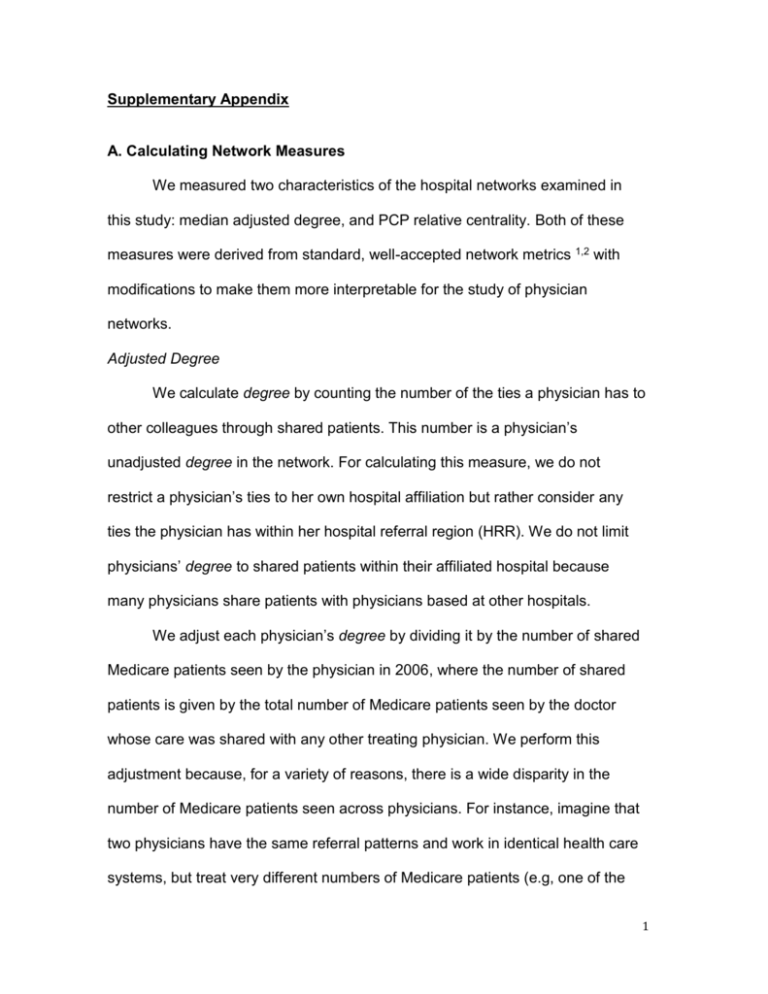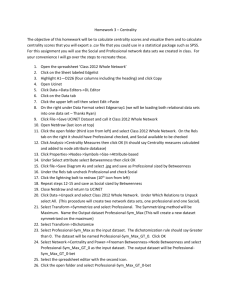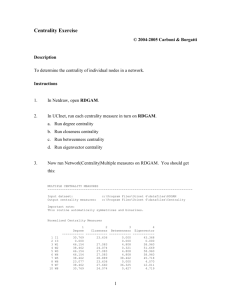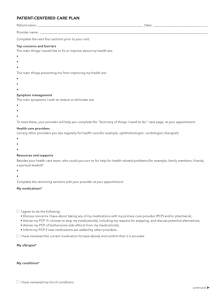Supplementary Appendix A. Calculating Network Measures We
advertisement

Supplementary Appendix A. Calculating Network Measures We measured two characteristics of the hospital networks examined in this study: median adjusted degree, and PCP relative centrality. Both of these measures were derived from standard, well-accepted network metrics 1,2 with modifications to make them more interpretable for the study of physician networks. Adjusted Degree We calculate degree by counting the number of the ties a physician has to other colleagues through shared patients. This number is a physician’s unadjusted degree in the network. For calculating this measure, we do not restrict a physician’s ties to her own hospital affiliation but rather consider any ties the physician has within her hospital referral region (HRR). We do not limit physicians’ degree to shared patients within their affiliated hospital because many physicians share patients with physicians based at other hospitals. We adjust each physician’s degree by dividing it by the number of shared Medicare patients seen by the physician in 2006, where the number of shared patients is given by the total number of Medicare patients seen by the doctor whose care was shared with any other treating physician. We perform this adjustment because, for a variety of reasons, there is a wide disparity in the number of Medicare patients seen across physicians. For instance, imagine that two physicians have the same referral patterns and work in identical health care systems, but treat very different numbers of Medicare patients (e.g, one of the 1 physicians may work part time). The physician with fewer shared Medicare patients will always look like she has a lower degree in this analysis despite having identical behavior and similar relationships when compared to the physician with more patients. Due to the fact that the median number of Medicare patients seen in 2006 by the physicians in our data was 120 and because of a previously published study using a similar measure 3, we decided to express the adjusted degree as degree per 100 Medicare patients. Lastly, because our analysis was centered on the hospital as a unit of analysis, we summarized the connectivity of physicians at a hospital by taking the median adjusted degree of all physicians affiliated with a hospital. Betweenness Centrality and Relative Centrality Several measures of centrality exist in the network literature. We chose to rely on the measure of betweenness centrality (the most commonly used measure) due to its applicability in a clinical context and straightforward interpretation. Betweenness centrality is a measure of how likely a member of a network is to be located on the shortest path between any two other members in a network. The equation for betweenness centrality is defined as follows:2 CB (ni ) g jk (ni ) g jk i jk N N = the set of all physicians in a network ni = the i-th physician CB(ni) = betweenness centrality of physician i (ni) 2 gjk = the number of shortest paths (also known as “geodesics”) which link physicians j and k gjk(ni) = the number of shortest paths which link physicians j and k that include physician i The expression inside the sum for the equation for CB(ni) becomes larger as networks become larger. This is because, in the case of most real-world networks, the number of possible shortest paths in a network grows with the size of a network, so CB can become arbitrarily large. This makes comparing betweenness centrality values between differently sized networks challenging. A normalization equation has been proposed, but has methodological shortcomings when comparing networks of very different sizes 2. We chose to bypass this shortcoming of comparing betweenness centrality values across networks by calculating the relative betweenness centrality, or relative centrality of groups of physicians in a single hospital, i.e. within a given network. The equation for relative centrality is defined as follows (using PCP relative centrality): CR C H , PCP C H , Non PCP CR relative PCP centrality for hospital H CH, PCP average betweenness centrality for all PCPs in hospital H CH, Non-PCP average betweenness centrality for all other physicians in hospital H The relative centrality, CR, enables us to look at how central one group of physicians is relative to others within a hospital. This value is weakly correlated 3 with the number of physicians of a hospital (r = -0.14 and 0.09 for PCP relative centrality and medical specialist centrality, respectively), versus extremely high correlations using the simple mean betweenness centrality values (r = 0.95 and 0.88 for PCP relative centrality and medical specialist centrality, respectively). Because some small hospitals in our dataset had mostly physicians who were either PCPs or medical specialists, the denominator for the expression for CR was 0 and could not be estimated. Likewise, for some hospitals, the denominator was very close to 0 and so CR became correspondingly large or small. We set these outlying values equal to the 1st and 99th percentiles, accordingly. Sensitivity analyses were performed on our models with various levels of cutoffs for the centrality values, with almost all of the effect of outlying values apparent after trimming the single most extreme centrality value. B. Statistical Approach Given the novel application of network measures for understanding physician networks, we did not start our investigation with any theoretical knowledge about the most appropriate functional form of the network measures relative to the outcomes. We decided to keep network measures in their original continuous form because there was no a priori science knowledge informing us that a particular categorization would be informative. We were also cautious about categorizing these predictors given the well-documented pitfalls of categorizing continuous predictors 4,5. We examined the univariate and joint distributions of the network measures used in this study, depicted in Appendix Figures 1 and 2. We also 4 measured the centrality of other physician groups, namely medical specialists, surgeons and “other” specialists. Medical specialist relative centrality was significantly correlated with the outcomes studied with similar magnitude, but opposite direction of PCP relative centrality (e.g. high specialist centrality was correlated with higher costs and utilization of care), but those results are not presented for the sake of clarity. Surgeon and other specialist centrality never emerged as statistically significant in any models. There is no substantial correlation between adjusted degree and the relative centrality measures. We then plotted the two network measures against the 9 outcomes used in this manuscript. Overall, no clear nonlinear trends were apparent. With just a few exceptions, our assessment was that all of the network measure versus costs and utilization relationships were well approximated by linear trends. We tested this impression by first entering the network measures as predictors in a multiple linear regression framework. We assessed model fit and the assumption of linearity of each of the predictors with thorough diagnostic checks, including partial residual plots. In the small number of cases where the plots might have suggested a different functional form, we also fit models using logarithmic, quadratic and cubic transformations of the network measures, but did not find that any consistently provided a better fit than the original measure. Therefore, we favor leaving the network measures as linear predictors, enabling simpler, more interpretable, and, most likely, more robust results. C. Details of Multiple Regression Models 5 In building our multiple regression models, we began with an interest in using the detailed hospital-level performance data available from the Dartmouth Atlas of Health Care as a set of outcome measures 6. We then performed a focused review of recent literature on hospital costs and quality and defined a set of control variables that we felt encompassed a wide array of likely confounders that could explain variation in hospital costs and health care utilization independently of network measures 7-10. Details on the data sources and which databases contained which variables are explained in the Methods section of the paper and in Appendix Table 1, below. One variable we eliminated from our prespecified group of covariates was a “technology index” which gave each hospital a score based on the level of advanced medical technology (e.g., robotic surgery) available at a hospital. We eliminated this variable because it has a high prevalence of missing data (~20%) and its inclusion in the model, with or without multiple imputation for missing data, made no substantive change in the results of our analyses. We fit a linear, log-normal multiple regression model with the following equation: ln(HospitalOutcome) 0 AdjustedDegree 1PCPRelativeCentrality β T HospitalCovariates Separate models were fit for each 9 hospital outcomes. The hospital outcomes, network measures, and hospital covariates are summarized in Appendix Table 1. 6 To account for the fact that smaller hospitals had fewer patients in the last 2 years of life for which to calculate the hospital outcomes used by the Dartmouth Atlas group, we weighted our regression models by the average number of annual deaths at each hospital during the period over which the outcomes data were gathered, 2001-2005. In addition, to account for the possibility that the variance of an observation varies with the corresponding mean or with values of the predictors, we used robust heteroscedastic-consistent standard error estimation procedures 11,12. D. Sensitivity Tests and Model Diagnostics We thoroughly evaluated the 9 models using a wide array of regression diagnostics. We found evidence of mild heteroscedasticity in the distribution of the residuals for several of the models, so we used robust heteroscedastic standard error estimation 11,12. Due to the number of covariates used in our regression models, we were concerned that the counterfactuals underlying the reported effects presented in Fig. 3 in the manuscript may be extrapolations not supported by actual observations in our data. In particular, we present the counterfactuals of the expected change in hospital outcomes given a change of 1 standard deviation in a network characteristic for the average non-profit, urban, non-teaching, hospital in our dataset. To insure that we were not reporting effects involving counterfactuals with no or minimal support from the data, we calculated the multidimensional Gower’s distance of these counterfactuals from our entire dataset 13,14. We found that for every effect we present in Figure 3, increasing or 7 decreasing any of the 2 network measures by 1 standard deviation, is within 0.1 Gower distance away from 89 or more other hospitals in the dataset 15. In summary, with sophisticated diagnostics proposed by King and Zeng, we found that the effects we report in Figure 3 are based on conservative, well-supported interpolations within our dataset. We conducted a wide range of sensitivity tests on our set of 9 models. First, we tested the effects of the categorization of hospitals into 2 or 3 categories of urban/rural location (either urban/non-urban or urban/rural/isolated) and teaching status (either teaching vs. non-teaching or major/minor/non-teaching). There was no substantive change to the results with either set of categorizations. We also added covariates to assess the influence of patient population, looking at the effect of adding mean patient age and percentage of black or white patients to our models. In addition, we examined the potential effect of Medicare Advantage penetration in regional markets on our models by calculating the percentage of patients enrolled in Medicare Advantage for at least one month in 2006 in each HRR and included this covariate in our model. The addition of these variables made no substantive difference to any of the results in the models. The addition of these variables also made no substantive difference to any of the results in the models. Sensitivity analyses on outlying data were also performed because we were concerned about their possible effect on our results. In particular, some models had a few observations whose residual values were quite large or small. We performed sensitivity analyses assessing the impact of these outliers by 8 excluding a few extreme outliers, and also excluding the outer 1st-10th percentile of residual outliers in our data from the models. We found that these changes had either a minimal effect or increased the estimates and precision of our results. We opted for the more conservative presentation of the results obtained by not excluding any outlying data. As described in part B above, we also performed sensitivity analyses on the effect of trimming the centrality ratios at various levels of cutoffs (1st-10th outer percentiles) for the centrality values, with almost all of the effect of outlying values apparent after trimming the single most extreme centrality value. We decided to set the most extreme centrality ratios to the 1st and 99th percentile values. Lastly, we simulated the effect of a hypothetical unobserved confounder on the results of our models. We created a series of simulated binary unobserved confounders for all models in the manuscript with a range of associations with both the network measures and outcomes of interest. The associations with both outcome and network predictor ranged from a log odds ratio of -3 to a log odds ratio of 3, a range far greater than one might expected for a predictor for which we and others have no knowledge of to date. We simulated an unobserved confounder with an average prevalence of 50%. We found that in general, most models were not sensitive to an unobserved confounder without a very strong association with both the outcome and confounder. Exceptions included median adjusted degree vs. medical/surgical days and PCP centrality vs. total costs and total PCP visits. All of these associations had confidence intervals closest to including 0 among the significant results presented in Fig. 3. In these models, a 9 binary unobserved confounder with a log odds ratio association with a standard deviation change in the network predictor or outcome of +/- 0.5 to 1.0 (exact values depending on the model) could take away the statistical significance of the result. Overall, we found that the majority of our statistically significant results held up to unobserved confounding, unless the unobserved confounder was strongly associated with both the predictor and the outcome (with far stronger associations than seen with any of the measured confounders we included in our analyses). The results that were more sensitive to unobserved confounding (discussed above) were the weaker associations presented in the results. It is possible an unobserved confounder exists that could be similar to the confounder we simulated, but in most cases it is improbable that we and others are completely unaware of a factor that has such a strong association to both cost/utilization outcomes and network properties. 10 Appendix References 1. Newman M. The structure and function of complex networks. SIAM Reviews 2003. 2. Wasserman S, Faust K. Social Network Analysis: Methods and Applications. Cambridge, MA: Cambridge University Press; 1994. 3. Pham HH, O'Malley AS, Bach PB, Saiontz-Martinez C, Schrag D. Primary care physicians' links to other physicians through Medicare patients: the scope of care coordination. Annals of internal medicine 2009;150:236-42. 4. Royston P, Altman DG, Sauerbrei W. Dichotomizing continuous predictors in multiple regression: a bad idea. Stat Med 2006;25:127-41. 5. Problems Caused by Categorizing Continuous Variables. 2010. (Accessed October 4, 2010, 2010, at http://biostat.mc.vanderbilt.edu/wiki/Main/CatContinuous.) 6. Wennberg JE, Fisher E, Goodman DC, Skinner J. Tracking The Care of Patients with Severe Chronic Illness: The Dartmouth Atlas of Health Care, 2008. Lebanon, NH: The Dartmouth Institute for Health Policy & Clinical Practice, Center for Health Policy Research,; 2008. 7. Jha AK, Orav EJ, Dobson A, Book RA, Epstein AM. Measuring efficiency: the association of hospital costs and quality of care. Health affairs (Project Hope) 2009;28:897-906. 8. Landon BE, Normand S-LT, Lessler A, et al. Quality of care for the treatment of acute medical conditions in US hospitals. Archives of internal medicine 2006;166:2511-7. 9. Barnato AE, Chang CC, Farrell MH, Lave JR, Roberts MS, Angus DC. Is survival better at hospitals with higher "end-of-life" treatment intensity? Medical care 2010;48:125-32. 10. Yasaitis L, Fisher ES, Skinner JS, Chandra A. Hospital quality and intensity of spending: is there an association? Health affairs (Project Hope) 2009;28:w566-72. 11. Zeileis A. Econometric Computing with HC and HAC Covariance Matrix Estimators. Journal of Statistical Software 2004;11:1-17. 12. White H. A heteroskedasticity-consistent covariance matrix and a direct test for heteroskedasticity. Econometrica 1980;48:817-38. 13. King G, Zeng L. The Dangers of Extreme Counterfactuals. Political Analysis 2006;14:131-59. 14. King G, Zeng L. When Can History be Our Guide? The Pitfalls of Counterfactual Inference. International Studies Quarterly 2007;51:183-210. 15. Stoll H, King G, Zeng L. WhatIf: Software for Evaluating Counterfactuals. In. R package version 1.5-5 ed; 2009. 16. Bynum JP, Bernal-Delgado E, Gottlieb D, Fisher E. Assigning ambulatory patients and their physicians to hospitals: a method for obtaining population-based provider performance measurements. Health services research 2007;42:45-62. 11 Appendix Figure 1: Hospital Network Characteristics vs. Total Medicare Costs 600 Median Adjusted Degree 500 400 300 200 100 0.0 0.5 1.0 1.5 2.0 2.5 3.0 Relative PCP Centrality In this figure, each point represents a hospital. The size of each point corresponds to each hospital’s total Medicare spending. The x-axis corresponds to the relative primary care provider (PCP) centrality in that hospital, and the y-axis corresponds to the median adjusted degree of physicians in that hospital. Dashed lines are drawn at the median values of relative PCP centrality and median adjusted degree to guide the eye. In this figure, 18 hospitals (of 521 total with nonmissing values) with high PCP centralities > 3.2 fall outside the range of the plot. The concepts of adjusted degree and PCP centrality are presented in Fig. 1C and Fig. 2. The Pearson correlation coefficient of median adjusted degree versus PCP relative centrality is -0.04 (p = 0.35). 12 Appendix Figure 2: Univariate Distributions of Hospital Network Measures A B This figure shows histograms of the distribution of network measures across the 528 hospitals in the dataset used for this study. In App. Fig. 1B, one outlying centrality value (which equals approximately 17) falls outside the range of the plot. 13 Appendix Table 1: List of Hospital Outcomes, Network Measures and Hospital Covariates Hospital Outcomes (patients in last 2 years of life) Data Source: Dartmouth Atlas of Health Care Total Costs Imaging Costs Test/Laboratory Costs Total Hospital Days General Medical/Surgical Days ICU Days Total Physician Visits PCP Visits Medical Specialist Visits Network Measures Data Source: Medicare Claims Median Adjusted Degree PCP Relative Centrality Hospital Covariates Data Sources: American Medical Association (AMA), American Hospital Association (AHA), or derived from Medicare Claims Number of physicians (Medicare, see ref 16) Number of hospital beds (AHA) Number of RN FTE's per 1000 inpatient days (AHA) Percentage of Medicare admissions (AHA) Percentage of Medicaid admissions (AHA) Urban or non-Urban (AHA) Major, Minor or Non-Teaching (AHA) Non-profit, For-profit or Public (AHA) Mean patient volume of physicians (Medicare) Percentage of PCPs (AMA) 14 Appendix Table 2: Complete Regression Coefficient Tables Outcome Intercept Median Adjusted Degree PCP Relative Centrality Number of physicians Number of beds Number of RN FTE's per 1000 inpatient days Mean patient volume of physicians Percentage of Medicare admissions Percentage of Medicaid admissions Percentage of PCPs Minor teaching hospital (Reference: None) Major teaching hospital (Reference: None) Public hospital (Reference: Non-profit) For profit hospital (Reference: Non-profit) Non-urban hospital (Reference: Urban) Adj. R2 0.559 Beta 10.90 0.164 -0.062 -0.003 -0.016 -0.052 0.012 0.023 0.032 -0.047 -0.023 0.024 -0.030 0.028 -0.045 Outcome R2 Intercept Median Adjusted Degree PCP Relative Centrality Number of physicians Number of beds Number of RN FTE's per 1000 inpatient days Mean patient volume of physicians Percentage of Medicare admissions Percentage of Medicaid admissions Percentage of PCPs Minor teaching hospital (Reference: None) Major teaching hospital (Reference: None) Public hospital (Reference: Non-profit) For profit hospital (Reference: Non-profit) Non-urban hospital (Reference: Urban) Adj. 0.472 Beta 3.10 0.160 -0.043 -0.061 0.059 -0.115 0.037 0.052 0.035 -0.045 -0.026 0.011 -0.029 -0.031 0.085 Total Costs F-statistic 48 SE 0.016 0.016 0.011 0.013 0.011 0.009 0.012 0.011 0.011 0.013 0.019 0.030 0.023 0.025 0.024 p-value <0.001 p-value 0.000 0.000 0.000 0.816 0.126 Adj. R2 0.563 Beta 6.71 0.214 -0.097 0.067 -0.021 Imaging Costs F-statistic 48.9 SE 0.022 0.021 0.015 0.017 0.014 p-value <0.001 p-value 0.000 0.000 0.000 0.000 0.146 Adj. R2 0.489 Beta 6.19 0.195 -0.138 0.068 -0.042 0.000 0.327 0.042 0.003 0.000 0.234 0.417 0.189 0.275 0.063 -0.048 0.110 0.027 -0.011 -0.071 -0.116 -0.197 -0.020 0.070 -0.136 0.013 0.017 0.015 0.015 0.017 0.027 0.041 0.031 0.035 0.033 0.000 0.000 0.084 0.441 0.000 0.000 0.000 0.514 0.044 0.000 -0.087 0.125 0.025 0.024 -0.084 -0.088 -0.178 -0.082 0.088 -0.145 Hospital Days F-statistic p-value 34.3 <0.001 SE p-value 0.018 0.000 0.017 0.000 0.012 0.000 0.014 0.000 0.012 0.000 0.010 0.013 0.012 0.012 0.014 0.021 0.033 0.025 0.028 0.027 0.000 0.006 0.000 0.003 0.002 0.223 0.743 0.252 0.268 0.002 General Medical or Surgical Days Adj. R2 F-statistic p-value 0.299 16.7 <0.001 Beta SE p-value 2.19 0.027 0.000 0.082 0.026 0.002 -0.035 0.019 0.060 -0.045 0.021 0.031 0.056 0.018 0.001 -0.120 -0.020 0.070 0.045 -0.071 0.008 0.116 -0.090 -0.179 0.182 0.016 0.020 0.019 0.018 0.021 0.032 0.049 0.038 0.042 0.040 0.000 0.322 0.000 0.011 0.001 0.808 0.019 0.018 0.000 0.000 Test/Lab Costs F-statistic p-value 36.5 <0.001 SE p-value 0.027 0.000 0.026 0.000 0.018 0.000 0.021 0.001 0.017 0.014 0.016 0.020 0.018 0.017 0.021 0.032 0.049 0.037 0.042 0.040 0.000 0.000 0.171 0.162 0.000 0.005 0.000 0.029 0.036 0.000 Adj. 0.283 Beta 1.24 0.315 -0.058 -0.105 0.086 ICU Days F-statistic 15.5 SE 0.040 0.038 0.027 0.031 0.026 p-value <0.001 p-value 0.000 0.000 0.031 0.001 0.001 -0.079 0.155 0.003 0.026 0.020 -0.058 -0.166 0.074 0.241 -0.174 0.023 0.029 0.027 0.026 0.031 0.047 0.072 0.055 0.062 0.059 0.001 0.000 0.917 0.323 0.519 0.219 0.022 0.185 0.000 0.003 R2 15 Total Physician Visits Adj. R2 0.477 Beta 4.20 0.213 -0.090 -0.050 0.028 F-statistic 34.9 SE 0.019 0.018 0.013 0.015 0.012 p-value <0.001 p-value 0.000 0.000 0.000 0.001 0.025 Adj. R2 0.301 Beta 2.78 0.161 -0.064 -0.051 0.022 PCP Visits Fstatistic 17 SE 0.022 0.021 0.015 0.017 0.014 -0.093 0.108 0.031 0.014 -0.030 -0.062 -0.104 -0.083 0.044 -0.037 0.011 0.014 0.013 0.012 0.015 0.023 0.035 0.027 0.030 0.028 0.000 0.000 0.018 0.251 0.046 0.006 0.003 0.002 0.140 0.188 -0.099 0.042 0.079 0.038 0.066 -0.022 -0.021 -0.108 -0.009 0.027 0.013 0.017 0.015 0.014 0.017 0.026 0.040 0.031 0.035 0.033 Outcome Intercept Median Adjusted Degree PCP Relative Centrality Number of physicians Number of beds Number of RN FTE's per 1000 inpatient days Mean patient volume of physicians Percentage of Medicare admissions Percentage of Medicaid admissions Percentage of PCPs Minor teaching hospital (Reference: None) Major teaching hospital (Reference: None) Public hospital (Reference: Non-profit) For profit hospital (Reference: Non-profit) Non-urban hospital (Reference: Urban) Medical Specialist Visits p-value <0.001 p-value 0.000 0.000 0.000 0.003 0.121 Adj. R2 0.557 Beta 2.61 0.338 -0.159 -0.090 0.060 F-statistic 47.7 SE 0.034 0.032 0.023 0.026 0.022 p-value <0.001 p-value 0.000 0.000 0.000 0.001 0.006 0.000 0.011 0.000 0.008 0.000 0.399 0.601 0.001 0.791 0.407 -0.132 0.231 -0.021 0.016 -0.141 -0.092 -0.120 -0.129 0.141 -0.231 0.020 0.025 0.023 0.022 0.026 0.040 0.061 0.047 0.053 0.050 0.000 0.000 0.369 0.456 0.000 0.022 0.051 0.007 0.008 0.000 16









